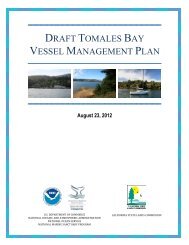Symposium program - Gulf of the Farallones National Marine ...
Symposium program - Gulf of the Farallones National Marine ...
Symposium program - Gulf of the Farallones National Marine ...
Create successful ePaper yourself
Turn your PDF publications into a flip-book with our unique Google optimized e-Paper software.
14<br />
<strong>Marine</strong> Biology and Ecology Research Group, School <strong>of</strong> Biological Sciences, University <strong>of</strong> Plymouth, Drake Circus,<br />
Plymouth PL4 8AA, UK<br />
Application <strong>of</strong> Molecular Genetics for Conservation <strong>of</strong> <strong>the</strong> Great White Shark,<br />
Carcharodon carcharias, L. 1758<br />
Although a species capable <strong>of</strong> long distance dispersal, Carcharodon carcharias exhibits philopatric behaviour,<br />
with females known to return to natal sites. However, intractability and rarity mean knowledge <strong>of</strong> its population<br />
dynamics remain limited. Direct observation, by tagging or photographic tracking, <strong>of</strong>ten lack, respectively,<br />
repeatability and objectivity, but advances in molecular genetics and genomic analysis provide indirect<br />
assessments <strong>of</strong> population connectivity, substructuring and dispersal. In this study, various genetic markers<br />
were successfully used to study <strong>the</strong> population structure <strong>of</strong> C. carcharias. Development <strong>of</strong> a new marker and <strong>the</strong><br />
largest sample panel so far assembled for population genetic analyses has given <strong>the</strong> highest resolution <strong>of</strong> white<br />
shark population structure to-date. Concordance <strong>of</strong> direct (photographic identification) and indirect (molecular<br />
tools) methods <strong>of</strong> individual identification was assessed to validate proposed white shark local movements.<br />
Female mating strategies were investigated and set in <strong>the</strong> context <strong>of</strong> a global phylogeographic study <strong>of</strong> <strong>the</strong><br />
white shark, utilizing 304 individuals caught worldwide. For <strong>the</strong> first time multiple paternity was documented<br />
in Lamniform species, conforming to <strong>the</strong> typical mating pattern <strong>of</strong> elasmobranchs studied to date. Finally,<br />
<strong>the</strong> presence <strong>of</strong> matrilineal clades among oceans was revealed, markers, supporting <strong>the</strong> hypo<strong>the</strong>sis <strong>of</strong> female<br />
philopatry with gene flow mediated by both sexes. These findings are essential to <strong>the</strong> management <strong>of</strong> white shark<br />
populations, a species that has already been classified as ‘Vulnerable’ by <strong>the</strong> IUCN.<br />
Malcolm P. Francis 1 , Clinton Duffy2 , Ramon Bonfil 3 , Michael J. Manning 1,4<br />
1<br />
<strong>National</strong> Institute <strong>of</strong> Water and Atmospheric Research, New Zealand<br />
2<br />
Department <strong>of</strong> Conservation, New Zealand<br />
3<br />
2233 Caton Ave. 5C, Brooklyn, NY, 11226 USA<br />
4<br />
Deceased<br />
Diving behaviour <strong>of</strong> New Zealand great white sharks (Carcharodon carcharias) recorded by popup<br />
archival tags<br />
Between 2005 and 2009, 25 great white sharks were tagged with popup satellite tags around New Zealand.<br />
Nineteen <strong>of</strong> <strong>the</strong> tags have reported useful data, including four which have been recovered, thus providing high<br />
resolution archival information on depth and temperature. We analysed <strong>the</strong>se datasets to characterise depthrelated<br />
behaviour patterns while in <strong>the</strong> vicinity <strong>of</strong> seal colonies and while crossing open oceans to subtropical<br />
and tropical regions. The sharks exhibited considerable plasticity, staying mostly in shallow water less than 50<br />
m deep while patrolling around seal colonies, but switching between surface swimming and deep diving while<br />
crossing oceans. During ocean migrations, all sharks dived periodically to depths greater than 500 m, down to<br />
a maximum <strong>of</strong> 1,000 m. New data from recent tag recoveries will be presented, and used to provide a picture <strong>of</strong><br />
<strong>the</strong> vertical distribution <strong>of</strong> this species in <strong>the</strong> south-west Pacific Ocean.<br />
Michael Gottfried 1 , Leonard Compagno 2 , and Anna Jerve 3<br />
1<br />
Michigan State University Museum, East Lansing, Michigan, 48824-1045<br />
2<br />
Shark Research Centre, Iziko South African Museum, Cape Town 8000, South Africa<br />
3<br />
Evolutionary Organismal Biology, Uppsala University, 75236 Uppsala, Sweden<br />
Skeletal Anatomy <strong>of</strong> Carcharodon carcharias<br />
Many basic aspects <strong>of</strong> white shark anatomy are poorly known, and in many cases <strong>the</strong> limited information that is<br />
available is inaccurate. This includes <strong>the</strong> incomplete and <strong>of</strong>ten erroneous descriptions <strong>of</strong> <strong>the</strong> skeletal anatomy <strong>of</strong><br />
this iconic species, which compromises attempts to resolve controversial issues regarding <strong>the</strong> interrelationships<br />
<strong>of</strong> white sharks with o<strong>the</strong>r lamnids and <strong>the</strong>ir fossil relatives. To address this situation, we recently completed<br />
a detailed study describing <strong>the</strong> white shark skeleton. Several wet-preserved skeletons were prepared from<br />
specimens in <strong>the</strong> collections <strong>of</strong> <strong>the</strong> Iziko South African Museum and KwaZulu-Natal Sharks Board (<strong>the</strong> use<br />
<strong>of</strong> carefully prepared wet-preserved material avoids <strong>the</strong> problems <strong>of</strong> distortion that occur when cartilaginous<br />
shark skeletons are kept as dried specimens, a factor that contributed to earlier inaccurate accounts). Distinctive<br />
features <strong>of</strong> white shark cranial and branchial anatomy include a blunt tripartite rostrum with a small rostral<br />
node, greatly enlarged nasal capsules, very large stapedial fenestra in <strong>the</strong> suborbital shelf, massive palatoquadrate<br />
and Meckel’s cartilages with a “double” jaw joint that permits a shifting point <strong>of</strong> articulation, and a complex







